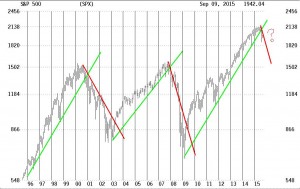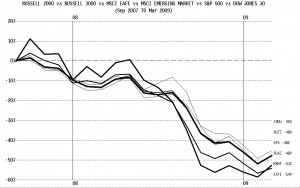World stock markets have been increasingly volatile this summer. Returns for market indices have turned negative and the S&P 500 suffered its first 10% correction since 2012. Because of this, I have received several message in my inbox that ponder what do in this environment. A couple of the titles were “”What you should do in volatile and uncertain markets”” and “”When market conditions become volatile, how will you react?”” The two main strategies that they suggest are 1) stay the course and 2) a diversified portfolio is the best way to be positioned. While this seems sensible in a bull market cycle, these two strategies do not work in a bear market cycle. Therefore, the most important question is not what to do in a volatile market, but is this a bear market?
Stay the course (doesn't work)
The stay the course theory may make sense if you are an investor that doesn't monitor the markets on a daily basis and can't forecast what is coming next. However if you are paying an advisor, don't you think that they should avoid at least part of a major downturn? At Runnymede, we believe that asset protection is a huge part of investment management and sidestepping just a portion of a major downdraft is not only good for the bottom line but also for a client's physical health. Looking at the chart below, it seems obvious that staying the course has been a poor strategy over the past 15 years. With two bear markets of -50%+, managing risk by lowering equity exposure at peak multiples was the right strategy, not staying the course.

A diversified portfolio is (not) the best way to position for whatever comes next
If you are in your 30s or 40s, most investors have high allocations to equities. Often times they have almost all of their portfolio in equities. To lower the amount of risk, many advisors diversify across market capitalizations, sectors and countries. However, in a bear market, this strategy isn't very effective. Let's take a look at how different equity strategies performed in 2008.

Academic research tell us that during periods of crisis and high stock market volatility, correlations among equity asset classes increase. In other words, stocks move down together and diversification is not enough to protect your assets. It didn't matter if you were in emerging markets (MEMF), small caps (RUTZ), large caps (SPX and INDU), healthcare, international (EAFE) or Apple stock, everything went down significantly.
Reduce risk before the storm
The only strategy that works in a bear market is to reduce risk before the significant drawdown. Don't sell at the bottom of the market — that is a losing proposition. It is imperative to reduce exposure to risk assets like equities when you are late in the bull market cycle and heading into the new bear. This means moving money to more stable assets like US Treasuries or cash. This will allow you to not only weather the storm which can last 6-18 months but it also allows you to buy stocks that you love at much lower prices!
Are we in a bear market today? In recent weeks, we have written that we believe that the US is heading toward recession, valuations are stretched and earnings are in decline. The writing is on the wall and we believe that we are in the early stages of a bear market. There are times to be aggressive and times to be defensive. This is a time to de-risk and move to safer assets.
By





